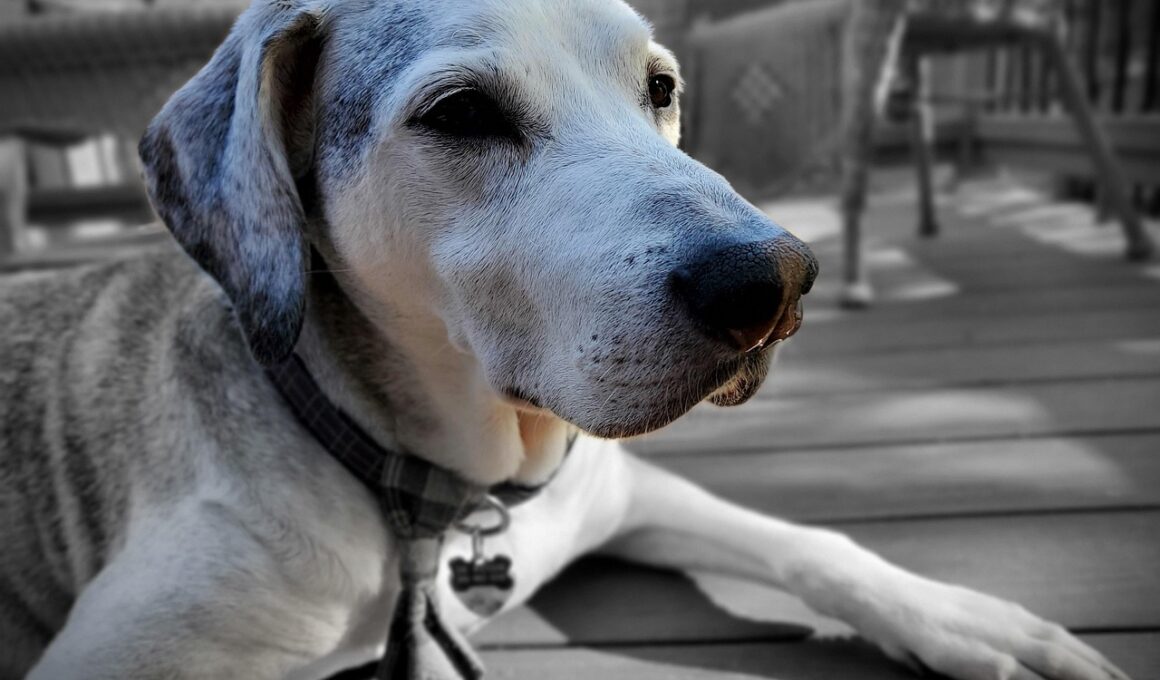Tracking Progress in Senior Dog Physical Therapy
Physical therapy for senior dogs is a crucial approach to improving their quality of life. Recognizing how effective these therapies are hinges on consistent evaluation. Regular assessments can help track improvements and setbacks in your dog’s mobility and comfort. Many owners are unaware of the gradual improvements that can surface with physical therapy. Assessments can range from observing how your dog moves to structured tests by a veterinarian. Monitoring progress through professional help encourages transparency in the therapy process. Owners may also keep a journal noting physical changes and behavioral reactions during exercises. Specifically, recording changes in gait, flexibility, and energy levels can be helpful indicators. Emphasizing the importance of safe exercise and therapeutic activities can create confidence in your dog. With consistency in evaluations, owners can adjust therapy routines to match their dog’s needs. This tailored approach could enhance recovery rates and increase overall happiness. Positive reinforcements like treats and play can also be integrated within these activities. Taking time to celebrate small victories can boost motivation for both the owner and their dog. Ultimately, progress tracking is essential in maximizing benefits from senior dog physical therapy.
A vital part of tracking progress involves establishing measurable goals for therapy sessions. Owners should work closely with veterinary professionals to set realistic expectations based on their dog’s health status. Common goals include improved range of motion, increased stamina, and enhanced physical activity levels. Regular assessments can reveal how close the dog is to meeting these targets. Each assessment should be documented meticulously, noting specific improvements and challenges the dog encounters. Certain tools can aid in tracking the expected outcomes of physical therapy. For instance, using simple visual analog scales to assess pain or discomfort can provide insights. Additionally, mobility aids like harnesses might be used for evaluating load-bearing capacities. Observing behavioral changes, such as eagerness for walks or playing, can signal improvements. Another effective method is to film therapy sessions for comparative analysis over time. This visual documentation highlights progress more strikingly, helping validate the effectiveness of the interventions. Owners should also communicate openly with their vets about any concerns that arise during therapy. Transparency helps tailor physical therapy plans that adapt to specific needs and challenges. Constant evaluation and adaptation lead to successful outcomes in senior dog physical therapy.
Common Techniques for Evaluating Effectiveness
There are several techniques available to evaluate the effectiveness of physical therapy in senior dogs effectively. One notable method is gait analysis, which can provide insights into the overall mobility of your dog. Observing your dog walk or run can reveal important changes, such as limping or uneven movement patterns. Another useful technique is strength testing, which measures your dog’s muscle tone and strength over time. Veterinary professionals often implement resistance exercises that allow them to quantify improvements precisely. Additionally, pain assessment tools can help gauge discomfort levels during and after therapy sessions. Using numerical scales or visual aids to get feedback from owners can enhance understanding of a dog’s pain thresholds. Range of motion assessments can also significantly indicate progress in senior dogs; therapists can perform passive and active stretching to evaluate joint flexibility. Regular flexibility evaluations help ensure that dogs maintain their physical capacity. Lastly, behavioral observations play a major role in assessing therapy effectiveness. Positive changes in demeanor or activity levels often reflect physical improvements. Using a combination of these techniques can create a comprehensive evaluation strategy for senior dog physical therapy.
Engaging your dog during therapy sessions is crucial for overall effectiveness. Making these sessions enjoyable not only enhances cooperation but also increases the likelihood of positive outcomes. Incorporating toys during exercises can stimulate your dog’s interest and focus. Using treat-based rewards ensures that dogs remain motivated throughout the therapy. Owners should also tailor activities to suit their dogs’ preferences and capabilities. For example, use different terrains or change the pace during walks while working on mobility drills. Incorporating fun swimming sessions can be particularly beneficial for low-impact exercise. By allowing the dog to enjoy physical activities, it reduces resistance against therapy. Additionally, maintaining a positive atmosphere can mitigate any anxiety related to the therapy. This supportive environment should facilitate bonding, contributing to success in rehabilitation. Regular interaction between the therapist, owner, and the dog enhances communication. Utilizing visual cues, such as hand signals or verbal praise, during sessions can solidify the dog’s learning experience. Over time, the reinforcement of these connections fosters trust, essential in evaluating the effectiveness of the physical therapy. An enjoyable experience ensures consistent participation and engagement, significantly elevating the chances of reaching desired therapy goals.
Long-term Observations and Adjustments
Long-term observations are instrumental in ensuring the longevity of benefits from physical therapy in senior dogs. Keeping notes over extended periods helps owners see trends that may not be immediately obvious. Regular evaluations can highlight gradual improvements or the need for further interventions. Owners should consider checking in with veterinary professionals at intervals to discuss observations and make necessary adjustments. These reflections encourage discussions about lifestyle changes and restorative exercises that may be needed. Tracking changes could lead to modifications in therapy to address new challenges that arise. Specific, ongoing assessments should focus on overall health status, flexibility, and mobility. It’s also essential to closely observe the dog’s interaction with its environment for behavioral assessments. Analyzing how dogs respond to different stimuli can provide added context for improvements or decline. Owners should share changes in their dog’s routines and any unusual behaviors with professionals, as this information can be crucial. Adjustments based on long-term data ensure that therapy becomes a dynamic process, adapting to each dog’s evolving needs. Following consistent adjustments, owners can strive for optimal care, significantly improving the quality of life for senior dogs.
In learning to evaluate the effectiveness of physical therapy, awareness of potential challenges is important. Some senior dogs may resist therapy, not due to a lack of effectiveness but because of discomfort or fear. Recognizing these emotional factors can influence how therapy is approached. Approaching physical therapy with empathy promotes better outcomes, as dogs are more receptive to training when they feel safe. Owners should aim to identify individual barriers while remaining patient, as any resistance may necessitate adjustments. Adapting goals to align with the dog’s feelings and experiences makes therapy success more achievable. Furthermore, recognizing physical limitations can help set realistic expectations for recovery times. It’s fundamental to celebrate small milestones along the way, no matter how minor they may seem. Acknowledging these can motivate both dogs and owners to stay committed to the process. Understanding common side effects of physical therapy, such as temporary soreness or fatigue, prepares owners for realistic experiences. Engaging with other pet owners who have faced similar situations can further provide valuable support. These forms of community support can lead to shared success stories and strategies. Connecting with professionals can facilitate a more adaptive therapy approach for each senior dog.
Conclusion and Future Perspectives
In conclusion, evaluating the effectiveness of physical therapy in senior dogs is a multifaceted approach. Ongoing assessments using a variety of methods allow owners to better understand how therapy impacts their dogs. Consistent documentation of observations and progress fosters successful adaptations in therapy routines. Ensuring enjoyable, engaging sessions can yield higher success rates by promoting motivation and participation. Long-term tracking is essential not only for identifying progress but also for recognizing challenges and fears. Owners must work hand in hand with veterinary professionals for balanced therapy assessments and adjustments. Clear communication regarding observations leads to tailored therapy sessions that suit individual needs. As new methodologies and techniques emerge in dog therapy, staying informed is valuable for ongoing evaluation. Owners who embrace a proactive approach in assessing their dogs’ progress will foster a deeper bond while enhancing efficacy related to therapy. Ultimately, a dedicated approach encourages a fulfilling quality of life for senior dogs, enabling them to enjoy their golden years. Continued research will likely yield innovations enhancing the effectiveness of physical therapy for dogs. Passionate advocacy for these methods can significantly promote the well-being of family pets everywhere.


